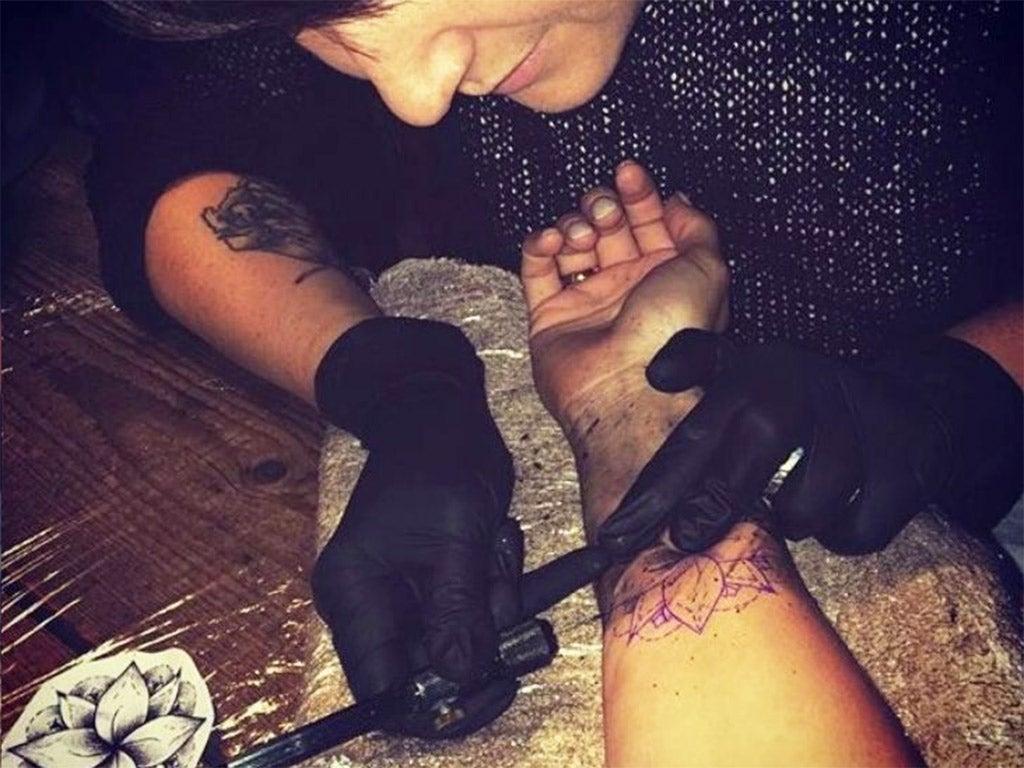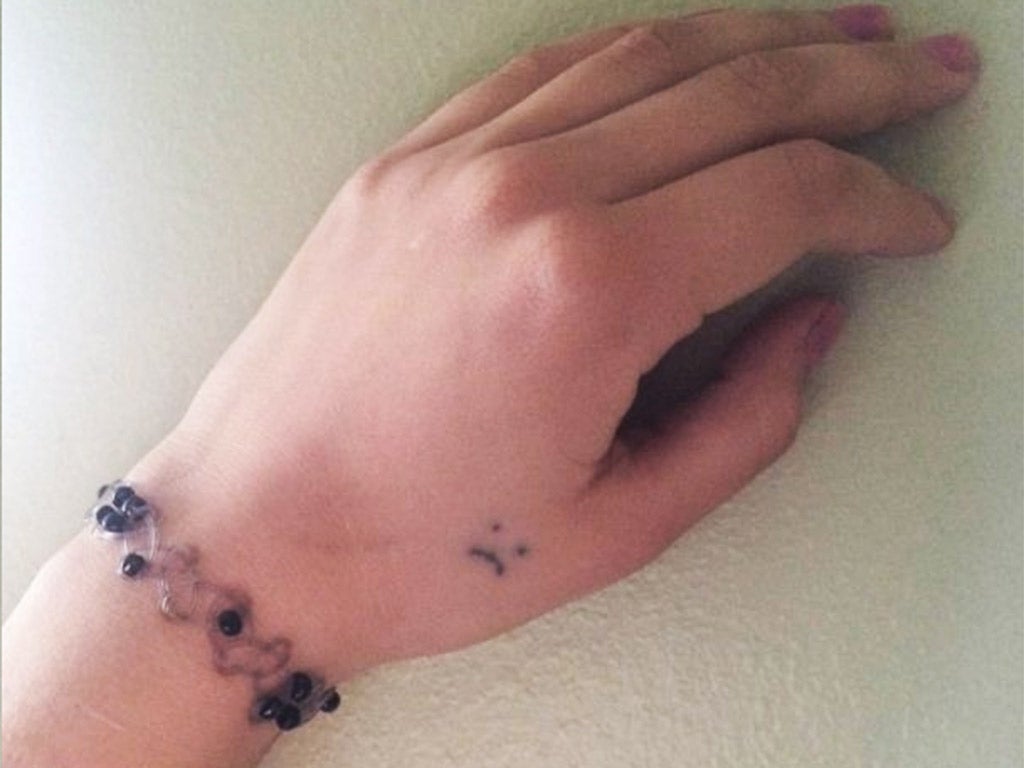DIY 'stick-and-poke' tattoos are on the rise - but come with serious health risks
With tattoos now gone mainstream, DIY 'stick-and-poke' versions are becoming a cooler alternative

Your support helps us to tell the story
From reproductive rights to climate change to Big Tech, The Independent is on the ground when the story is developing. Whether it's investigating the financials of Elon Musk's pro-Trump PAC or producing our latest documentary, 'The A Word', which shines a light on the American women fighting for reproductive rights, we know how important it is to parse out the facts from the messaging.
At such a critical moment in US history, we need reporters on the ground. Your donation allows us to keep sending journalists to speak to both sides of the story.
The Independent is trusted by Americans across the entire political spectrum. And unlike many other quality news outlets, we choose not to lock Americans out of our reporting and analysis with paywalls. We believe quality journalism should be available to everyone, paid for by those who can afford it.
Your support makes all the difference.The needle pokes into your skin, piercing it so that the tattoo drips into your flesh. Poke, poke, poke.
It hurts, but don't you dare wince – you're the one hammering the ink into yourself. A heart on your wrist, a leaf on your ankle, the word "remember" on your ribs. It's like what you used to doodle with a pen in Year 8, only this time, it's permanent.
This is "stick-and-poke", a method of tattooing once reserved for jailbirds but now increasingly popular among young people and creative types.
As with traditional tattoos, stick-and-pokes are meant to provide a reminder of a milestone passed or a daily inspiration towards a future goal. But now that practically everyone in your life has a pricey tattoo-parlour memento somewhere on their flesh – your boss, your mum – the allure of rebellion they once commanded has been lost.
But a tat you did yourself with little more than a common sewing needle? Cue the raising of eyebrows.
Health experts raise concerns about the risks of blood-borne disease and infections associated with DIY tattooing, given that people might not disinfect their implements. The safest stick-and-pokes are drawn with professional-calibre tattoo ink or Indian ink from a reputable shop – but it's completely possible, and terribly fashionable, just to break open a ballpoint pen.
"It's kind of blowing up at the moment among people who want something that's not the mainstream," says British artist Sarah March, who began doing stick-and-pokes on her friends two years ago after seeing the trend on Instagram.
Now, she does them professionally, for people of all ages. Many are inspired by tattoos that appear to be stick-and-pokes on celebrities such as Rihanna and Kesha. Others are drawn to the small symbol tattoos they're seeing all over Pinterest and Tumblr. Some like the idea of a traditional tattoo but are too intimidated to actually do it.
"The atmosphere when you're getting a stick-and-poke tattoo is much more relaxed," March says. "There's a real personal aspect which you wouldn't generally get in a normal tattoo parlour."
Most people skip the professionals altogether and create tattoos from items lying around the house, or with a few inexpensive online purchases. They are meant to last as long as regular tattoos, but are known to fade eventually, depending on how much ink is poked into the skin and how deep it goes.

Tutorials explaining how to do your own tattoos can be found online in seconds. First, the needle is typically attached to an object that makes it easier to hold, such as a pencil. Then a thread is wound tightly around the needle. When the needle is dipped into ink, this thread holds the liquid, which drips into the skin as the needle is pressed down about one-eighth of an inch. Repeat a few times, and you've got yourself a tattoo.
It was that easy for Stephanie Hernandez, an 18-year-old who inked herself along with a friend in September, a few weeks into her first year at the University of California, Berkeley. "It's a thing I had always wanted to do but never really had the guts to do it," Hernandez says. "I got a sad face on myself, and she got a heart. It was a rebellion of sorts: like, oh, I'm independent now."
The tiny sad face sits on her hand, between her index finger and her thumb. She intended to add a second pair of eyes so that it would look like a happy face from a different angle, but the tattooing took so long that she never really got around to it. At the time, she was feeling pretty sad anyway: her grandfather had died, there was drama in her family, and the emotions of settling into a new place were overwhelming.
"When I look at it now, I see how I've grown so much since I got it," she says.
Over the holidays, her family couldn't seem to understand the sad face's higher purpose; they just sighed in relief that the tattoo is so small.
Instagram and Pinterest are full of more radical examples: the faces of Beavis and Butthead on a guy's knees; the words "Now can an angel break my heart?" across a sternum; "DON'T WAKE" on a pair of eyelids. Professionally inked tattoos have just as much potential to turn regrettable, but the cost and process of setting up an appointment can serve as a buffer to impulsiveness.
Even more serious than regretting your home-made ink is the possibility of getting sick from it. "The contamination of materials with biological pathogens from sharing needles with your friends can happen, whether you sterilise it quickly with a match or not," says Nicole West, a former biology teacher who began considering the risks of stick-and-pokes when she was getting a circle on her wrist from a friend. "You're young, you're intoxicated, you don't know – HIV, hepatitis C, all the major killers that are blood-borne can be passed quickly."
So she began selling kits online, filled with sterile materials and directions for how to do stick-and-poke safely. For $42 (£29), you get professional tattoo ink, sterile needles, stencil paper, wipes, medical gloves and aftercare balm.

Although she has been criticised for selling a product that encourages at-home tattooing, West argues that the kit is safer than any other at-home method. Even with those precautions, there is still potential for something to go wrong. As with traditional tattoos, it's very possible to have an allergic reaction to the ink, for example.
"Especially with these inks from a pen – what else is in it? Nothing meant to be placed in the body," says Cameron Rokhsar, an associate clinical professor of dermatology at Mount Sinai Hospital, New York, who has removed handmade tattoos from patients. (They're typically easier to remove than regular tattoos, because there is less ink in the skin.)
Enthusiasts say not to expect this trend to be as easily wiped away – people tattooed themselves long before there were machines to do it for them or iPhones to put their art on Instagram. But chances are, DIY tats will never be a major threat to the traditional tattoo industry. In many states and countries it's illegal to tattoo others without a licence. And even if your friend is a great artist and a steady-handed tattooist, a stick-and-poke will always have a different look from a professional one, says Denver graphic designer Evan Lorenzen (who has both): "It's like playing a synthesizer versus a piano: they both are capable of creating beautiful sounds. But with very different tones and personalities."
© Washington Post
Join our commenting forum
Join thought-provoking conversations, follow other Independent readers and see their replies
4Comments